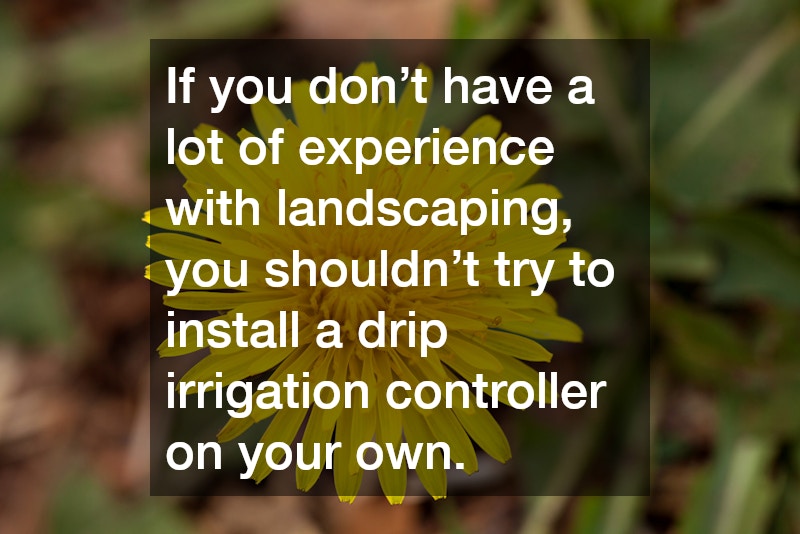
Sometimes, landscaping is more about function than fashion. When landscaping your home and installing a new irrigation system, for example, you don’t need to be a hero and use the most complicated methods to achieve your goal. Sometimes, using drip irrigation tools or installing an automatic watering device for maximum irrigation can be the best idea even if it means that your landscaping project won’t look as good as it might if you spend a lot of time and money going through a less efficient process. If the amount of effort you invest in landscaping doesn’t pay itself back to your satisfaction after completing the job, it’s simply not worth it and you should simplify your process.

If you don’t have a lot of experience with landscaping, you shouldn’t try to install a drip irrigation controller on your own. As you probably know, the easiest way to get a landscaping job done such as installing an irrigation system using drip irrigation tools or putting an automatic watering device in place is hiring someone else to do it. Beyond calling professional landscapers, our tips below will help you make your next landscaping project more enjoyable and less stressful.

Homeowners schedule a landscaping consultation typically to create a landscape style that provides a yard they can enjoy every day. This consultation might include tips on garage landscaping or how to imbue a shady backyard with grass. Landscapers typically suggest at least one area for a garden bed and a pathway from the home to a focal point in the yard, such as a gazebo or fountain. Your landscape architect might also suggest hardscapes – the solid structures that form a part of every landscape, such as driveways, retaining walls, and benches.
Most homeowners don’t expect the landscaper to suggest tree removal. It happens in more than a few yards because one dead tree or infected tree can lead to the destruction of all the trees in a yard. Plant diseases spread quickly, so removing a sick tree can save the other trees in a yard. The landscaper can plant a sapling in its place. If termites invade a tree in your yard, a savvy landscaper will recommend removing that tree and treating the yard for the bugs so you stop their spread.

Do you have a yard? If yes, are there trees in it? If not, how close are the nearest trees?
This may seem silly, but the truth is that being near trees is good for you. It’s good for your health, it’s good for your brain, and it’s good for your wallet. Here are some landscaping tips that can help all of those things.
- Plant Trees There’s an old expression: “The best time to plant a tree is 20 years ago. The second best time is today.” Trees are obviously great because of the way they process carbon dioxide and turn it into oxygen, but did you know that trees can also reduce your heating and cooling bills? Adding trees to a house with minimal shade can reduce air conditioning costs by as much as 50%. While planting fully grown trees is a serious undertaking and probably calls for professional landscapers, planting a smaller tree only requires a shovel.
- Read up on Landscaping Design Knowing how you want to organize your lawn is every bit as important as what you actually put in the ground. Maximizing your landscaping by using stone pavers, porous asphalt, or climate-specific flowers can enhance your home value and show off your property. For commercial buildings, high-end landscaping speeds up the sales of buildings by several weeks. Furthermore, Money Magazine says that the return on investment for landscaping work can be as high as 200%.
- Know your Surroundings Landscaping tips aren’t just about what types of flowers to plant and when to plant them. Landscaping tips are also about your town. For instance, if you live in a city or crowded suburb, the U.S. Environmental Protection Agency suggests that trees reduce ambient noise by as much as 50%. Granted that’s another part of the reason you should plant trees, but if you’re already living in the woods, you should look into something else, like rain-barrels or flowering plants which thrive in the shade.
- Talk to your Local Landscaping CompanyYou can do this with a greenhouse, a nursery, or an exterior design company as well — not necessarily just a landscaper. These people know your local soil, they know what kind of wildlife will eat your plants, and they know what’s not worth trying to grow at your house. For example, if you’re in northern Minnesota and you want to grow banana trees, your local landscapers will offer alternatives (which might include “move to Costa Rica”). In short, these people will be able to offer site-specific landscaping tips.
It may seem simple, but learning about your particular landscape will go a long way in knowing what you can do at your home. If you’re an apartment-dweller, consider window-boxes for flowers or spices. If you have dozens of acres, start digging some holes. How you utilize your land can play a major part in bringing down your energy bills and increasing your peace of mind.